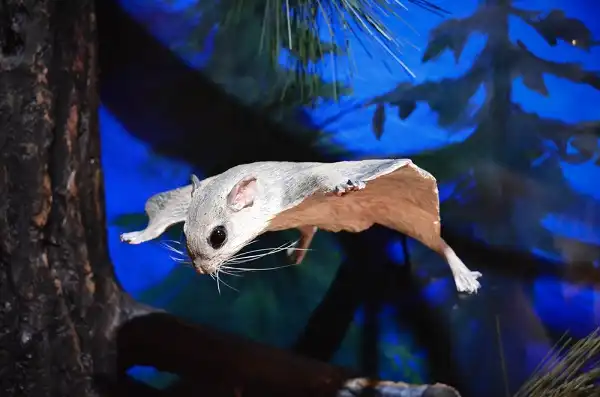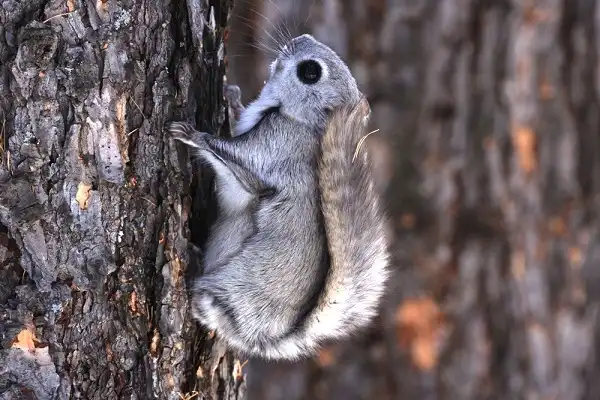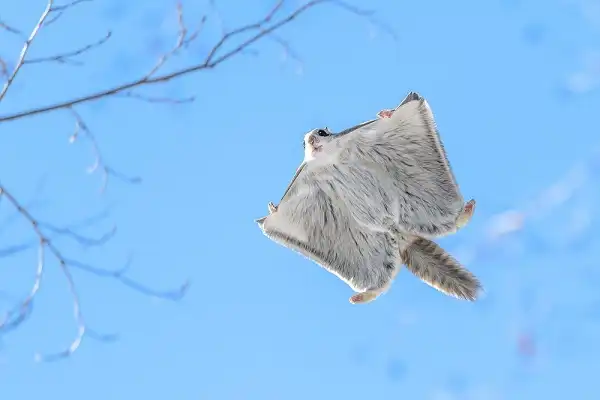Have you ever seen a flying squirrel? Though it may look like these animals can actually fly through the air, their ability to glide from one tree to another is more akin to sailing than actual flying. With an extra flap of skin that stretches between their two front and back legs, they catch currents in the air and propel themselves forward over impressive distances! From forest sightings around the globe to backyard visitors that seem friendly enough for a photo-op, let’s explore everything there is to know about these amazing creatures that make us marvel.

Flying Squirrel Description
The flying squirrel is a small, nocturnal mammal that lives in temperate and boreal forests all over the world. These fascinating creatures are members of the rodent family and have a body that is well-adapted to living in trees. Their fur is typically soft and grayish-brown or reddish-brown in color with white underbellies. They have large, black eyes which help them to see in low light conditions, as well as long whiskers which they use to sense their environment. The most impressive feature of these animals is their ability to glide from tree to tree. With an extra flap of skin known as a patagium stretching between their two front and back legs, they catch currents in the air and propel themselves forward at impressive distances.
In addition, flying squirrels have several other adaptations that make them expert climbers and jumpers. They have strong claws on their feet which help them cling onto surfaces with ease, as well as curved hind feet with sharp claws that allow them to grip tree trunks while jumping off of them. As a result, they are adept at navigating through treetops without making any noise or disturbing other animals in the area.
Flying Squirrel Habitat
Flying squirrels typically inhabit boreal, temperate, and northern coniferous forests all over the world. These small mammals prefer areas with tall trees which provide them with plenty of opportunities to climb and jump from one tree to another. They also need ample amounts of vegetation for food, nesting materials, and cover from potential predators. In addition to their ability to glide between tall trees, flying squirrels have developed several other adaptations that make them adept climbers and jumpers.
They have strong claws on their feet which help them cling onto surfaces with ease, as well as curved hind feet with sharp claws that allow them to grip tree trunks while jumping off of them. As a result, they are able to easily traverse treetops without disturbing any animals in the area. The flying squirrel is an important species in its habitat; its population serves as a source of food for many larger predators such as hawks, owls, foxes, and bobcats.
Flying Squirrel Diet
Flying squirrels are omnivorous creatures, with their diet consisting of both plant and animal matter. Plant sources include nuts, seeds, fruits, and fungi. They also eat tree sap and bark when food is scarce. Animal sources range from insects to bird eggs and nestlings. Flying squirrels have even been known to sometimes consume small birds or mammals such as mice. In addition to their regular diet, flying squirrels also feed on the sugary sap of trees in the spring and summer months when food is scarcer. They have specially adapted incisors that help them extract the sap from woody branches without hurting themselves in the process.
This behavior is known as “tapping” and helps flying squirrels obtain a valuable source of nutrition during the warmer months of the year. Due to their nocturnal lifestyle, flying squirrels often rely on stored reserves of fat for energy and nutrition during lean times in winter or when food sources are scarce or hard to find in the wild. To ensure that they can survive without food for extended periods of time, these animals build up fat reserves throughout the fall and early winter months so as to be able to sustain themselves until spring arrives with more favorable conditions.

Flying Squirrel Size
Flying squirrels are small, nocturnal mammals that typically range from 8 to 12 inches (20-30 cm) long and weigh between 2 and 4 ounces (60-120 grams). They have a bushy tail that ranges from 3 to 5 inches (7.5-12 cm) in length and is usually covered in a mix of grayish-brown or reddish-brown fur with white undersides. The most impressive feature of a flying squirrel is its ability to glide through the air using an extra flap of skin known as a patagium stretching between its two front and back legs.
When extended, this membrane creates an aerodynamic shape that allows them to cover up to 200 feet (around 60 meters) in one single leap! In addition, flying squirrels have several other adaptations that make them incredibly agile climbers and jumpers. They possess sharp claws on their feet which help them grip onto surfaces while navigating through treetops and curved hind feet with sharp claws that allow them to grab onto tree trunks while jumping off of them. These features combined make these furry creatures some of the best climbers in the animal kingdom!
Flying Squirrel Lifespan
The average lifespan of a flying squirrel varies depending on the species and its geographical location. In general, most species have an expected life expectancy of between 5-10 years in the wild. However, some individuals have been known to live up to 15 years or even longer in captivity. Flying squirrels are able to survive harsh weather conditions due to their thick fur coats that insulate them from the cold. They also have several behaviors that help them stay safe; such as huddling together for warmth and sheltering in tree hollows or abandoned bird nests when needed. These small mammals also possess impressive longevity thanks to their ability to store fat reserves during times of plenty, which can help them get through difficult periods without food or sources of nutrition. They have also adapted well to living near humans, where they often find plenty of food and other resources that wouldn’t be available in more rural areas.
Flying Squirrel Behavior
Flying squirrels are highly social animals who often live in small groups called colonies. They communicate with one another through a variety of vocalizations and scent marks. The behavior of these nocturnal creatures can vary greatly depending on the time of year; during winter months they will typically hunker down in their nests to conserve energy and stay warm while during spring and summer, they become much more active and adventurous, spending long days exploring their surroundings. Flying squirrels also show an impressive level of intelligence when it comes to problem-solving; they are able to learn quickly from their experiences, use tools, form hunting packs, and even remember the location of food sources.

Flying Squirrel Speed
Flying squirrels have impressive speed and agility that allows them to glide through the air with ease. They are able to reach speeds of up to 25 miles per hour (40 km/h) while gliding, and can cover distances over 200 feet (60 meters) in one single leap! This is made possible by their extra flap of skin known as a patagium which stretches between their two front and back legs facilitating an aerodynamic shape. Moreover, flying squirrels possess curved hind feet that allow them to grab onto tree trunks while jumping off of them and sharp claws on their feet that help them grip onto surfaces when navigating the treetops – all of which make for impressive mobility. In addition, these animals are incredibly agile climbers; they have been known to scale vertical walls over 44 feet high (13 meters)!
Flying Squirrel Hunting
Flying squirrels are highly adept hunters with sharp senses and impressive agility. They possess excellent eyesight which allows them to locate large prey from long distances, as well as exceptional hearing and a strong sense of smell that enables them to detect potential threats. When hunting, flying squirrels often use their gliding ability to move silently through the trees above their prey, making them almost undetectable to other animals. Additionally, they have powerful claws on their feet that allow them to grab onto surfaces when navigating through the treetops, as well as curved hind feet with sharp claws used for gripping tree trunks while jumping off of them. All these features combined make flying squirrels some of nature’s most efficient hunters! Overall, flying squirrels demonstrate remarkable hunting skills thanks to their impressive adaptation abilities and resourcefulness.
Flying Squirrel Reproduction
Flying squirrels are capable of reproducing year-round, with the most common mating season occurring during late winter and early spring. During this time, male flying squirrels will establish territories that they use to attract potential mates. The courtship ritual involves a variety of vocalizations, scents marks, and physical contact such as grooming and huddling together for warmth. Mating occurs after several days of courtship, with females giving birth to litters of 2-7 young after a gestation period of around 37 days.
The newborns are born blind and deaf with no fur; however their eyes open within the first 2 weeks and they start developing fur at around four weeks old. During their development, the young are cared for exclusively by their mother who provides them with food and protection until they become independent at around 3 months of age. Once independent, flying squirrels reach sexual maturity typically between one and 2 years old – at which point they will be ready to find their own mates and reproduce.

Conclusion
In conclusion, flying squirrels are truly remarkable creatures that demonstrate amazing adaptation skills which enable them to survive in a wide range of environments around the world. These small mammals possess impressive speed and agility when gliding through the air while their sharp claws allow them to climb trees with ease – making them some of nature’s most efficient predators. Additionally, they have strong social bonds amongst each other and are capable of reproducing year-round; these animals truly prove themselves as one of nature’s most resilient species!
Frequently Asked Question


